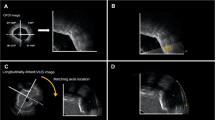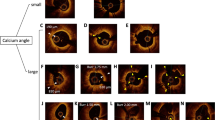Abstract
While optical frequency domain imaging (OFDI) can delineate calcium modification and fracture, the capability of high-definition intravascular ultrasound (HD-IVUS) for detecting these remains unclear. This study evaluated diagnostic accuracy of HD-IVUS for assessing calcium modification and fracture as compared to OFDI. HD-IVUS and OFDI were used during orbital or rotational atherectomy procedures conducted for 21 heavily calcified coronary lesions in 19 patients. With OFDI assessment used as the gold standard, diagnostic accuracies of HD-IVUS for calcium modification and fracture were compared every 1 mm to the matched pre-stenting images (n = 1129). Calcium modification, as assessed by OFDI, was defined as polished and concave-shaped calcium. For HD-IVUS, calcium modification was defined as the presence of reverberation with concave-shaped calcium. In both assessments, the definition of calcium fracture was defined as a slit or complete break in the calcium plate. Calcified plaque was found in 86.4% of analyzed OFDI images. Calcium modification and fracture were detected in 20.6% and 11.0% of detected calcified plaques. Sensitivity, specificity, positive and negative predictive values of HD-IVUS detection for calcium modification and fracture were 54.4%, 97.8%, 86.7%, 89.1% and 86.0%, 94.5%, 58.2%, 96.8%, respectively. Discordance cases between both assessments demonstrated that heterogeneous calcium visualized by OFDI, separated calcium, and guide wire artifact can be misdiagnosed. Diagnostic accuracies of HD-IVUS for assessing calcium modification and fracture were acceptable as compared to OFDI. Such findings can be of utility during imaging guided interventional procedures with atherectomy.





Similar content being viewed by others
References
Huisman J, van der Heijden LC, Kok MM, Louwerenburg JH, Danse PW, Jessurun GA et al (2017) Two-year outcome after treatment of severely calcified lesions with newer-generation drug-eluting stents in acute coronary syndromes: a patient-level pooled analysis from TWENTE and DUTCH PEERS. J Cardiol 69:660–665
Guedeney P, Claessen BE, Mehran R, Mintz GS, Liu M, Sorrentino S et al (2020) Coronary calcification and long-term outcomes according to drug-eluting stent generation. JACC Cardiovasc Interv 13:1417–1428
Hoffmann R, Mintz GS, Popma JJ, Satler LF, Kent KM, Pichard AD et al (1998) Treatment of calcified coronary lesions with Palmaz-Schatz stents. An intravascular ultrasound study. Eur Heart J 19:1224–1231
Fujino A, Mintz GS, Matsumura M, Lee T, Kim SY, Hoshino M et al (2018) A new optical coherence tomography-based calcium scoring system to predict stent underexpansion. EuroIntervention 13:e2182–e2189
Fujino A, Mintz GS, Lee T, Hoshino M, Usui E, Kanaji Y et al (2018) Predictors of calcium fracture derived from balloon angioplasty and its effect on stent expansion assessed by optical coherence tomography. JACC Cardiovasc Interv 11:1015–1017
Raber L, Mintz GS, Koskinas KC, Johnson TW, Holm NR, Onuma Y et al (2018) Clinical use of intracoronary imaging. Part 1: guidance and optimization of coronary interventions. An expert consensus document of the European association of percutaneous cardiovascular interventions. Eur Heart J 39:3281–3300
Sakakura K, Ito Y, Shibata Y, Okamura A, Kashima Y, Nakamura S et al (2021) Clinical expert consensus document on rotational atherectomy from the Japanese association of cardiovascular intervention and therapeutics. Cardiovasc Interv Ther 36:1–18
Maehara A, Matsumura M, Ali ZA, Mintz GS, Stone GW (2017) IVUS-guided versus OCT-guided coronary stent implantation: a critical appraisal. JACC Cardiovasc Imaging 10:1487–1503
Chambers JW, Feldman RL, Himmelstein SI, Bhatheja R, Villa AE, Strickman NE et al (2014) Pivotal trial to evaluate the safety and efficacy of the orbital atherectomy system in treating de novo, severely calcified coronary lesions (ORBIT II). JACC Cardiovasc Interv 7:510–518
Jang IK, Bouma BE, Kang DH, Park SJ, Park SW, Seung KB et al (2002) Visualization of coronary atherosclerotic plaques in patients using optical coherence tomography: comparison with intravascular ultrasound. J Am Coll Cardiol 39:604–609
Mintz GS, Douek P, Pichard AD, Kent KM, Satler LF, Popma JJ et al (1992) Target lesion calcification in coronary artery disease: an intravascular ultrasound study. J Am Coll Cardiol 20:1149–1155
Lee T, Mintz GS, Matsumura M, Zhang W, Cao Y, Usui E et al (2017) Prevalence, predictors, and clinical presentation of a calcified nodule as assessed by optical coherence tomography. JACC Cardiovasc Imaging 10:883–891
Lee JB, Mintz GS, Lisauskas JB, Biro SG, Pu J, Sum ST et al (2011) Histopathologic validation of the intravascular ultrasound diagnosis of calcified coronary artery nodules. Am J Cardiol 108:1547–1551
Yamamoto MH, Maehara A, Karimi Galougahi K, Mintz GS, Parviz Y, Kim SS et al (2017) Mechanisms of orbital versus rotational atherectomy plaque modification in severely calcified lesions assessed by optical coherence tomography. JACC Cardiovasc Interv 10:2584–2586
Kim SS, Yamamoto MH, Maehara A, Sidik N, Koyama K, Berry C et al (2018) Intravascular ultrasound assessment of the effects of rotational atherectomy in calcified coronary artery lesions. Int J Cardiovasc Imaging 34:1365–1371
Ali ZA, Maehara A, Généreux P, Shlofmitz RA, Fabbiocchi F, Nazif TM et al (2016) Optical coherence tomography compared with intravascular ultrasound and with angiography to guide coronary stent implantation (ILUMIEN III: OPTIMIZE PCI): a randomised controlled trial. The Lancet 388:2618–2628
Wang X, Matsumura M, Mintz GS, Lee T, Zhang W, Cao Y et al (2017) In vivo calcium detection by comparing optical coherence tomography, intravascular ultrasound, and angiography. JACC Cardiovasc Imaging 10:869–879
Pu J, Mintz GS, Biro S, Lee JB, Sum ST, Madden SP et al (2014) Insights into echo-attenuated plaques, echolucent plaques, and plaques with spotty calcification: novel findings from comparisons among intravascular ultrasound, near-infrared spectroscopy, and pathological histology in 2,294 human coronary artery segments. J Am Coll Cardiol 63:2220–2233
Ijichi T, Nakazawa G, Torii S, Nakano M, Yoshikawa A, Morino Y et al (2015) Evaluation of coronary arterial calcification—ex-vivo assessment by optical frequency domain imaging. Atherosclerosis 243:242–247
Rieber J, Meissner O, Babaryka G, Reim S, Oswald M, Koenig A et al (2006) Diagnostic accuracy of optical coherence tomography and intravascular ultrasound for the detection and characterization of atherosclerotic plaque composition in ex-vivo coronary specimens: a comparison with histology. Coron Artery Dis 17:425–430
Kobayashi N, Ito Y, Yamawaki M, Araki M, Obokata M, Sakamoto Y et al (2020) Optical coherence tomography-guided versus intravascular ultrasound-guided rotational atherectomy in patients with calcified coronary lesions. EuroIntervention 16:e313–e321
Shlofmitz E, Jeremias A, Shlofmitz R, Ali ZA (2019) Lesion preparation with orbital atherectomy. Interv Cardiol 14:169–173
Hill JM, Kereiakes DJ, Shlofmitz RA, Klein AJ, Riley RF, Price MJ et al (2020) Intravascular lithotripsy for treatment of severely calcified coronary artery disease. J Am Coll Cardiol 76:2635–2646
Hong SJ, Kim BK, Shin DH, Nam CM, Kim JS, Ko YG et al (2015) Effect of intravascular ultrasound-guided vs angiography-guided everolimus-eluting stent implantation: the IVUS-XPL randomized clinical trial. JAMA 314:2155–2163
Zhang J, Gao X, Kan J, Ge Z, Han L, Lu S et al (2018) Intravascular ultrasound versus angiography-guided drug-eluting stent implantation: the ultimate trial. J Am Coll Cardiol 72:3126–3137
Elbadawi A, Elzeneini M, Elgendy IY, Mahmoud K, Omer MA, Ogunbayo GO et al (2020) Temporal trends and outcomes of percutaneous coronary atherectomy in the United States. J Invasive Cardiol 32:E110-e121
Amemiya K, Yamamoto MH, Maehara A, Oyama Y, Igawa W, Ono M et al (2019) Effect of cutting balloon after rotational atherectomy in severely calcified coronary artery lesions as assessed by optical coherence tomography. Catheter Cardiovasc Interv 94:936–944
Matsukawa R, Kozai T, Tokutome M, Nakashima R, Nishimura R, Matsumoto S et al (2019) Plaque modification using a cutting balloon is more effective for stenting of heavily calcified lesion than other scoring balloons. Cardiovasc Interv Ther 34:325–334
Ono M, Kawashima H, Hara H, Gao C, Wang R, Kogame N et al (2020) Advances in IVUS/OCT and future clinical perspective of novel hybrid catheter system in coronary imaging. Front Cardiovasc Med 7:119
Acknowledgements
This work was supported by KAKENHI Grant Number 20K08142 from the Japan Society for the Promotion of Science (JSPS). The authors are deeply grateful to Tatsuya Shinke (image technician) for assisting in the performance of the image matching.
Author information
Authors and Affiliations
Corresponding author
Ethics declarations
Conflict of interest
Dr. Ishida receives lecture honoraria from Abbott Vascular Japan, Boston Scientific Japan, Daiichi Sankyo, Japan Lifeline, Kowa, Medikit and Terumo Corporation. Dr. Itoh receives lecture honoraria from Daiichi Sankyo, and Abbott Vascular. Dr. Morino received lecture honoraria from Abbott Vascular, Boston Scientific, Sanofi, and Daiichi-Sankyo. None of the other authors have any conflicts of interest or financial disclosures.
Additional information
Publisher's Note
Springer Nature remains neutral with regard to jurisdictional claims in published maps and institutional affiliations.
Rights and permissions
About this article
Cite this article
Ishida, M., Oshikiri, Y., Kimura, T. et al. High-definition intravascular ultrasound versus optical frequency domain imaging for the detection of calcium modification and fracture in heavily calcified coronary lesion. Int J Cardiovasc Imaging 38, 1203–1212 (2022). https://doi.org/10.1007/s10554-021-02521-8
Received:
Accepted:
Published:
Issue Date:
DOI: https://doi.org/10.1007/s10554-021-02521-8




